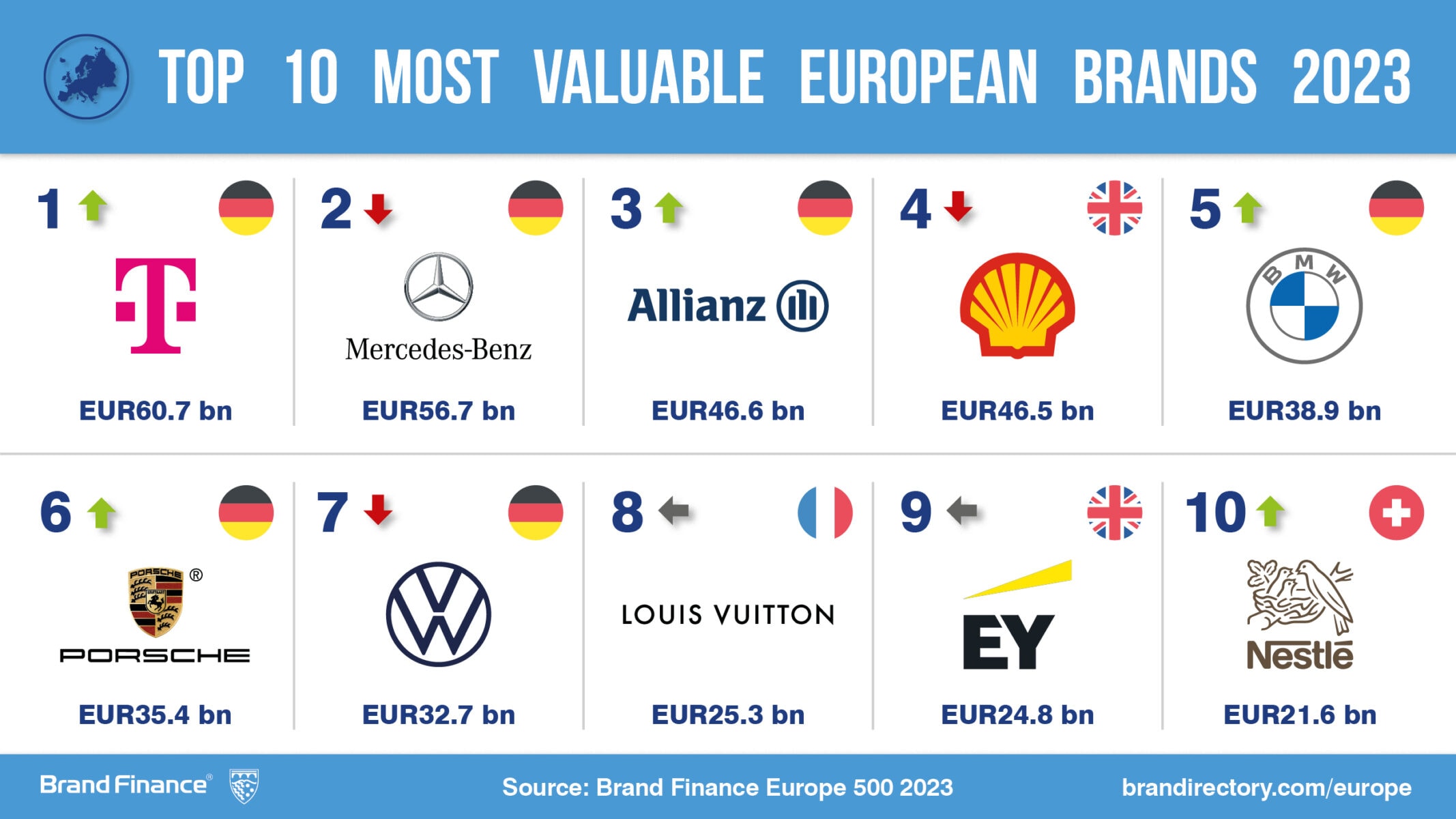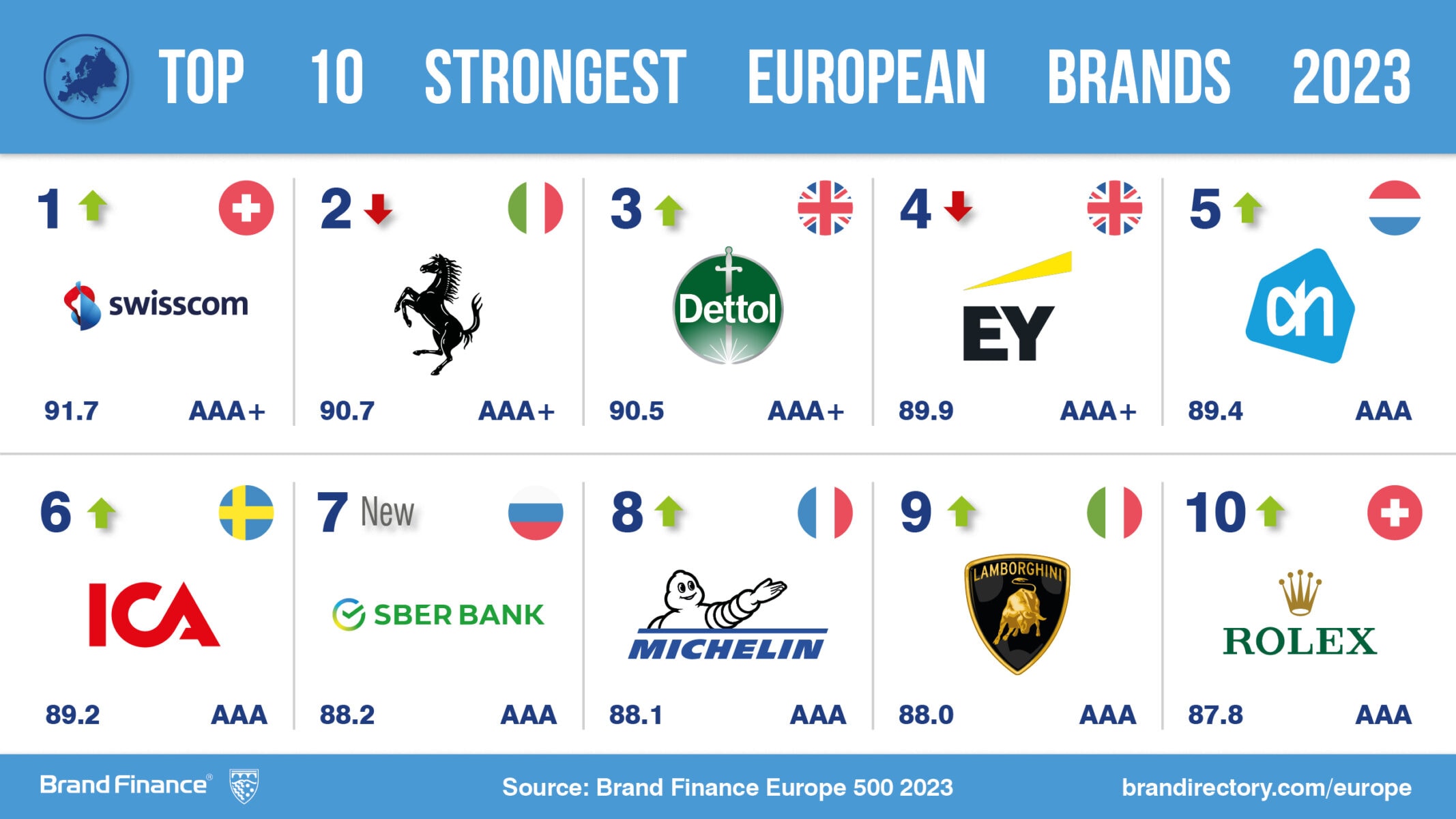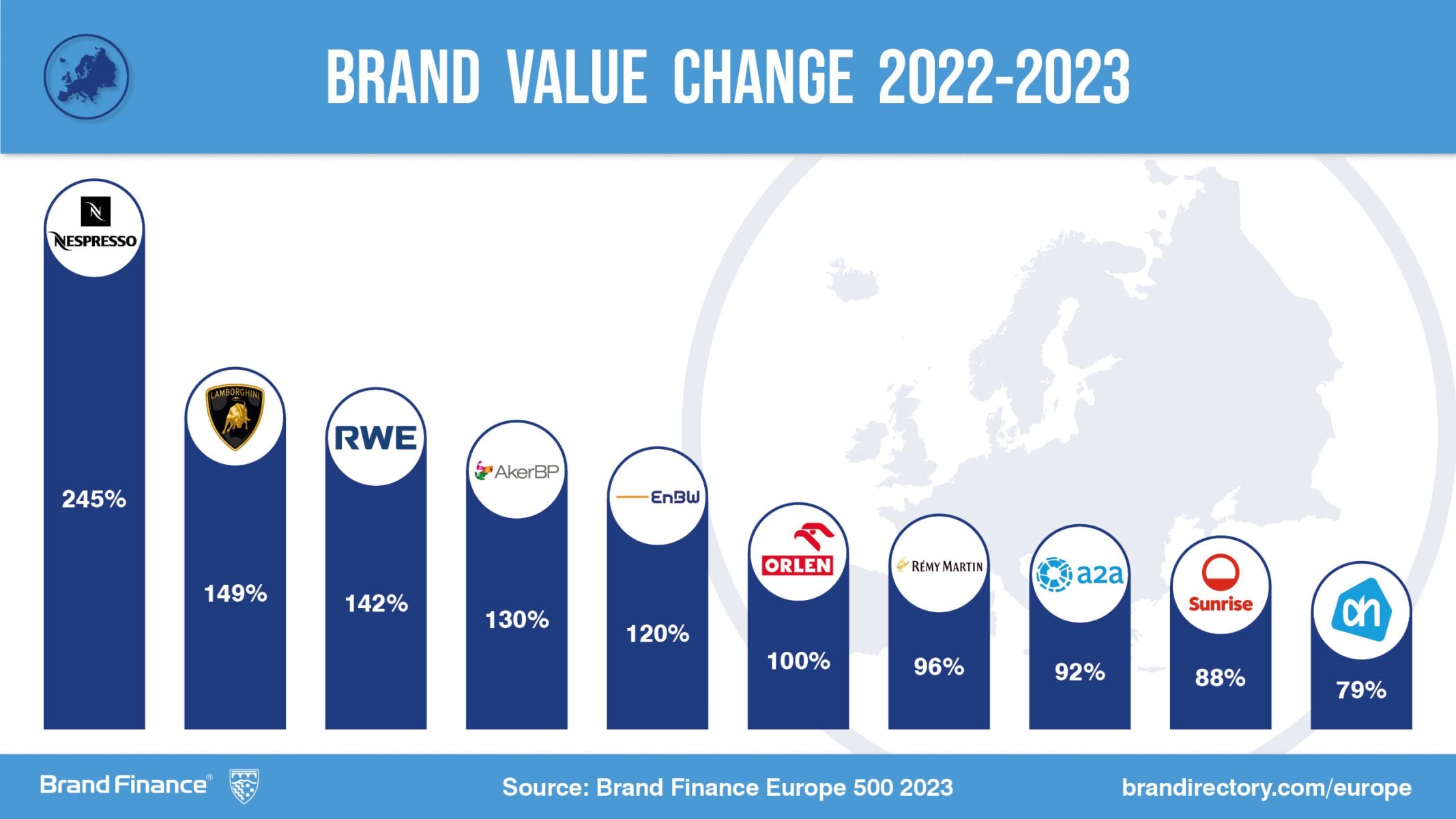Accedi alla classifica Brand Finance Europe 500 cliccando qui
Da quanto emerge dal nuovo report di Brand Finance Europe 500 2023 - società di consulenza leader nella valutazione dei marchi - Deutsche Telekom, con una crescita del 17%, raggiunge i 60,7 miliardi di euro e supera Mercedes-Benz diventando il brand europeo di maggior valore.

Ogni anno Brand Finance stima forza di attrazione dei 5.000 maggiori trademark del mondo e relativo valore finanziario. I risultati di queste analisi sono pubblicati in oltre 100 report, con principali marchi di tutti i settori e paesi ordinati per valore generato da immagine & reputazione.
Brand Finance per stimare il valore monetario dei trademark, oltre a tenere conto delle business performance, conduce una competitive analysis, tra marchi dello stesso settore, per determinare il livello di forza con cui i brand influenzano le scelte dei clienti. Quest’anno Swisscom, con un punteggio pari a 91,7 su 100, è il più forte tra i brand europei grazie ad un incremento di 2,9 punti, soprattutto grazie al forte apprezzamento presso i consumatori del mercato di riferimento. Il rafforzamento ha contribuito ad un incremento del valore del brand Swisscom pari al 18%. Diversamente Deutsche Telekom e i principali brand europei, sostanzialmente non hanno migliorato il livello di attrattività anno su anno.

Mettendo a confronto i risultati in euro dei principali 100 brand del mondo con i principali 100 europei con i principali 100 italiani emerge che gli europei anno su anno sono cresciuti del 15%, quelli italiani del 12% e quelli di maggiore valore al mondo, che sono al 50% americani sono cresciuti dell’8%. L’incremento di questi valori mediamente non risulta dipendere da un rafforzamento del livello di attrattività rispetto all’anno precedente, ma piuttosto da un incremento del fatturato che dipende in parte dalla buona gestione del branding degli anni precedenti e in parte dall’aumento dei prezzi.
Massimo Pizzo Senior Consultant di Brand Finance commenta: “L’incremento del valore dei brand presenti nella Global 500, nella Europe 500 e nella Italy 100, vista la sostanziale stabilità della forza di attrazione, è in buona parte dovuto all’incremento dei prezzi dovuto all’inflazione. Il mancato rafforzamento e il contestuale aumento di valore medio dei brand presenti nella Global 500, nella Europe 500 e nella Italy 100 deve suonare come un campanello di allarme per la marche che rischiano di perdere attrattività se non sono sufficientemente forti da tenere agganciati i clienti in fase di aumento dei prezzi.”
Nespresso è il brand europeo che cresce più velocemente, seguito da Lamborghini. Tra i 10 brand europei che crescono maggiormente c’è anche A2a che ha aumentato il valore generato da immagine & reputazione del 92%. Crescono molto bene, tra i principali marchi presenti in Italia anche Unicredit, Prada, Decathlon, Rolex, Chanel, Armani, Maserati e Conad.

Gucci, Enel ed Eni sono tra i primi 50 brand presenti nella classifica europea. In classifica troviamo 42 brand italiani, per un valore complessivo che pesa il 7% della classifica.
Continua Massimo Pizzo: “La presenza relativamente ridotta dei brand italiani nelle classifiche internazionali di Brand Finance dipende dalla dimensione medio piccola delle nostre imprese e quindi dalla ridotta capacità di investire sul branding e di generare business comparabile con quello delle altre nazioni con cui ci confrontiamo normalmente.”
Accedi alla classifica Brand Finance Europe 500 cliccando qui
Brand Finance is the world’s leading brand valuation consultancy. Bridging the gap between marketing and finance, Brand Finance evaluates the strength of brands and quantifies their financial value to help organisations make strategic decisions.
Headquartered in London, Brand Finance operates in over 25 countries. Every year, Brand Finance conducts more than 6,000 brand valuations, supported by original market research, and publishes over 100 reports which rank brands across all sectors and countries.
Brand Finance also operates the Global Brand Equity Monitor, conducting original market research annually on 6,000 brands, surveying more than 175,000 respondents across 41 countries and 31 industry sectors. By combining perceptual data from the Global Brand Equity Monitor with data from its valuation database — the largest brand value database in the world — Brand Finance equips ambitious brand leaders with the data, analytics, and the strategic guidance they need to enhance brand and business value.
In addition to calculating brand value, Brand Finance also determines the relative strength of brands through a balanced scorecard of metrics, compliant with ISO 20671.
Brand Finance is a regulated accountancy firm and a committed leader in the standardisation of the brand valuation industry. Brand Finance was the first to be certified by independent auditors as compliant with both ISO 10668 and ISO 20671 and has received the official endorsement of the Marketing Accountability Standards Board (MASB) in the United States.
Brand is defined as a marketing-related intangible asset including, but not limited to, names, terms, signs, symbols, logos, and designs, intended to identify goods, services, or entities, creating distinctive images and associations in the minds of stakeholders, thereby generating economic benefits.
Brand strength is the efficacy of a brand’s performance on intangible measures relative to its competitors. Brand Finance evaluates brand strength in a process compliant with ISO 20671, looking at Marketing Investment, Stakeholder Equity, and the impact of those on Business Performance. The data used is derived from Brand Finance’s proprietary market research programme and from publicly available sources.
Each brand is assigned a Brand Strength Index (BSI) score out of 100, which feeds into the brand value calculation. Based on the score, each brand is assigned a corresponding Brand Rating up to AAA+ in a format similar to a credit rating.
Brand Finance calculates the values of brands in its rankings using the Royalty Relief approach – a brand valuation method compliant with the industry standards set in ISO 10668. It involves estimating the likely future revenues that are attributable to a brand by calculating a royalty rate that would be charged for its use, to arrive at a ‘brand value’ understood as a net economic benefit that a brand owner would achieve by licensing the brand in the open market.
The steps in this process are as follows:
1 Calculate brand strength using a balanced scorecard of metrics assessing Marketing Investment, Stakeholder Equity, and Business Performance. Brand strength is expressed as a Brand Strength Index (BSI) score on a scale of 0 to 100.
2 Determine royalty range for each industry, reflecting the importance of brand to purchasing decisions. In luxury, the maximum percentage is high, while in extractive industry, where goods are often commoditised, it is lower. This is done by reviewing comparable licensing agreements sourced from Brand Finance’s extensive database.
3 Calculate royalty rate. The BSI score is applied to the royalty range to arrive at a royalty rate. For example, if the royalty range in a sector is 0-5% and a brand has a BSI score of 80 out of 100, then an appropriate royalty rate for the use of this brand in the given sector will be 4%.
4 Determine brand-specific revenues by estimating a proportion of parent company revenues attributable to a brand.
5 Determine forecast revenues using a function of historic revenues, equity analyst forecasts, and economic growth rates.
6 Apply the royalty rate to the forecast revenues to derive brand revenues.
7 Discount post-tax brand revenues to a net present value which equals the brand value.
Brand Finance has produced this study with an independent and unbiased analysis. The values derived and opinions presented in this study are based on publicly available information and certain assumptions that Brand Finance used where such data was deficient or unclear. Brand Finance accepts no responsibility and will not be liable in the event that the publicly available information relied upon is subsequently found to be inaccurate. The opinions and financial analysis expressed in the study are not to be construed as providing investment or business advice. Brand Finance does not intend the study to be relied upon for any reason and excludes all liability to any body, government, or organisation.
The data presented in this study form part of Brand Finance's proprietary database, are provided for the benefit of the media, and are not to be used in part or in full for any commercial or technical purpose without written permission from Brand Finance.